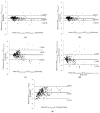Modeling Energy Expenditure Estimation in Occupational Context by Actigraphy: A Multi Regression Mixed-Effects Model
- PMID: 34639718
- PMCID: PMC8508338
- DOI: 10.3390/ijerph181910419
Modeling Energy Expenditure Estimation in Occupational Context by Actigraphy: A Multi Regression Mixed-Effects Model
Abstract
The accurate prediction of energy requirements for healthy individuals has many useful applications. The occupational perspective has also been proven to be of great utility for improving workers' ergonomics, safety, and health. This work proposes a statistical regression model based on actigraphy and personal characteristics to estimate energy expenditure and cross-validate the results with reference standardized methods. The model was developed by hierarchical mixed-effects regression modeling based on the multitask protocol data. Measurements combined actigraphy, indirect calorimetry, and other personal and lifestyle information from healthy individuals (n = 50) within the age of 29.8 ± 5 years old. Results showed a significant influence of the variables related to movements, heart rate and anthropometric variables of body composition for energy expenditure estimation. Overall, the proposed model showed good agreement with energy expenditure measured by indirect calorimetry and evidenced a better performance than the methods presented in the international guidelines for metabolic rate assessment proving to be a reliable alternative to normative guidelines. Furthermore, a statistically significant relationship was found between daily activity and energy expenditure, which raised the possibility of further studies including other variables, namely those related to the subject's lifestyle.
Keywords: energy expenditure; metabolic assessment; mixed-effects model; occupational health.
Conflict of interest statement
The authors declare no conflict of interest.
Figures


Similar articles
-
A pocket-sized metabolic analyzer for assessment of resting energy expenditure.Clin Nutr. 2014 Apr;33(2):341-7. doi: 10.1016/j.clnu.2013.06.001. Epub 2013 Jun 10. Clin Nutr. 2014. PMID: 23827182
-
A Single-Center Prospective Observational Study Comparing Resting Energy Expenditure in Different Phases of Critical Illness: Indirect Calorimetry Versus Predictive Equations.Crit Care Med. 2020 May;48(5):e380-e390. doi: 10.1097/CCM.0000000000004282. Crit Care Med. 2020. PMID: 32168031
-
[Analysis of energy expenditure in adults with cystic fibrosis: comparison of indirect calorimetry and prediction equations].Arch Bronconeumol. 2007 Jul;43(7):366-72. doi: 10.1016/s1579-2129(07)60087-1. Arch Bronconeumol. 2007. PMID: 17663888 Spanish.
-
Measurement of human energy expenditure, with particular reference to field studies: an historical perspective.Eur J Appl Physiol. 2012 Aug;112(8):2785-815. doi: 10.1007/s00421-011-2268-6. Epub 2011 Dec 11. Eur J Appl Physiol. 2012. PMID: 22160180 Review.
-
Can measured resting energy expenditure be estimated by formulae in daily clinical nutrition practice?Curr Opin Clin Nutr Metab Care. 2005 May;8(3):319-28. doi: 10.1097/01.mco.0000165012.77567.1e. Curr Opin Clin Nutr Metab Care. 2005. PMID: 15809536 Review.
Cited by
-
Human-in-the-Loop Optimization of Knee Exoskeleton Assistance for Minimizing User's Metabolic and Muscular Effort.Sensors (Basel). 2024 May 22;24(11):3305. doi: 10.3390/s24113305. Sensors (Basel). 2024. PMID: 38894101 Free PMC article.
References
-
- Lucena A.D., Guedes J.C.C., Vaz M.A.P., Da Silva L.B. Physiological variables in energy expenditure estimation by actigraphy: A systematic review protocol. Int. J. Occup. Environ. Saf. 2018;2:59–66. doi: 10.24840/2184-0954_002.001_0007. - DOI
-
- Chen J., Mitrouchev P., Coquillart S., Quaine F. Disassembly task evaluation by muscle fatigue estimation in a virtual reality environment. Int. J. Adv. Manuf. Technol. 2016;88:1523–1533. doi: 10.1007/s00170-016-8827-6. - DOI
Publication types
MeSH terms
LinkOut - more resources
Full Text Sources

